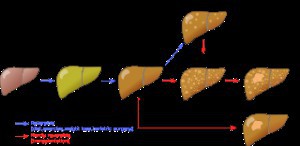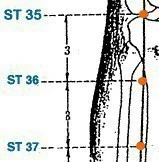Simple Combination of 3 Acupuncture Points Suppresses Systemic Inflammation and Reduces Oxidative Stress

Our body needs to keep a strong balance between helpful antioxidants, such as those found in plant based whole foods diets, and free radicals which have far more potential for damage. The body experiences "oxidative stress" when the balance of antioxidant activity is too low in relation to the activity of free radicals. While it is true that your body needs free radicals as they have important roles in immune function, when they start to overrun the body serious damage will happen. This process of oxidative stress is linked to aging in general and many increasingly common health issues including diabetes, cardiovascular conditions such as hypertension and heart disease, various cancers, and neurodegeneative diseases such as parkinson's and alzheimer's.
Moving towards a whole foods diet (study) and relaxation exercises such as tai chi (study) and meditation (study) are some research backed ways to work towards limiting the destructive changes from oxidative stress and associated inflammatory processes.
Acupuncture is well understood, both in research and in clinical outcomes, to benefit a broad range of inflammatory based conditions. And while there are literally volumes of research in support of acupuncture for many conditions and countless positive clinical experiences over hundreds if not thousands of years, the actual mechanisms in scientific terms as to how acupuncture is helping are still being explored.
To continue the exploration of the biochemical effects of acupuncture, researchers from the Kanazama Medical University in Ishikawa Japan recently conducted a study entitled "Acupuncture on ST36, CV4 and KI1 Suppresses the Progression of Methionine- and Choline-Deficient Diet-Induced Nonalcoholic Fatty Liver Disease in Mice."
The model of nonalcoholic fatty liver disease is an important one as research is leading towards understanding it as a multisystem disease (study) which is involved in many of the major health problems we face in our modern society (i.e. diabetes, cardiovascular issues, etc.).
Using an nonalcoholic fatty liver disease induced mouse model the researchers divided the mice into a true acupuncture treatment group and a sham needling group using nonacupoints. Due to their broad effects on the digestive system, liver function and general immune health (in Chinese Medicine terms), the researchers selected the following 3 acupuncture treatment points:
 ST 36 - named "Leg Three Li" (li also known as the "chinese mile") gives the impression of strengthening the body to travel long distances and this point is in fact used for broad systemic weaknesses in the body or what is more commonly called spleen qi deficiency in Chinese Medicine (see "My Spleen is What?" for a basic presentation of this conceptual system).
ST 36 - named "Leg Three Li" (li also known as the "chinese mile") gives the impression of strengthening the body to travel long distances and this point is in fact used for broad systemic weaknesses in the body or what is more commonly called spleen qi deficiency in Chinese Medicine (see "My Spleen is What?" for a basic presentation of this conceptual system).- CV 4 - named "Origin Pass" which indicates the role of the point in working with our deepest energetic reserves (kidney qi deficiency in Chinese Medicine terms - see "My Kidneys are What?" for more), it is used for broad systemic weaknesses in nearly all aspects of the body, particularly with regards to deeper issues, fertility, chronic disease processes and aging generally.
- KD 1 - named "gushing spring" is a critically important point not only in acupuncture usage but also in arts such as tai chi and qi gong exercises. In energetic terms it descends energy in the body. In more western terms it works towards limiting the damaging effects of stress responses (i.e. upward rising energy, headaches, anger, insomnia, etc.). It can even be used to help a person regain consciousness, for example (after anesthesia).
After performing acupuncture for two weeks, the researchers compared the sham acupuncture and the true acupuncture treatment groups. They found that while the sham group was looking jaundice, the acupuncture treatment group was observably healthier, showing a bright red color. In their blood the found the following:
- Triglycerides were decreased - triglycerides are the most common type of fat found in your body. Increases can come from regularly eating more calories than you need, particularly in the forms of sugar and carbohydrates, smoking, excessive drinking and a host of interrelated medical conditions. High triglycerides are strongly associated with nonalcoholic fatty liver disease as well as high cholesterol and diabetes (study).
- Free fatty acids were decreased - free fatty acids are the major fat fuel in the body and it is believed that when these are elevated in the blood they are thought to raise the risk of cardiovascular disease by causing insulin resistance (study).
- 8-hydroxy-2'-deoxyguanosine (8-OHdG)-positive hepatocytes were significantly lowered - 8-OHdG is a critical biomarker for oxidative stress and damage related to various cancers (study)
- Hepatic thiobarbituric acid reactive substances (TBARS) were also significantly lower - a very useful marker for oxidative stress activity in the body.
The researchers concluded that "acupuncture repressed the progression of NAFLD by inhibiting inflammatory reactions, reducing oxidative stress, and promoting lipid metabolism of hepatocytes".
In actual clinical reality the points would be tailored to each individual using the important diagnostic tools available to a fully trained acupuncturist. However, these are very important points and any one of those points is likely to be part of many clinically applied protocols. It is interesting to note that some of the Chinese Medicine theory related phrases such as "qi defciency" and "descending qi" begin to take on a far less abstract or "non scientific" life when you read them in the context of what modern research is concluding that the points get the body to do. This is important to keep in mind when discussing acupuncture with non professionals as the specialized theoretical language of Chinese Medicine can lead others to discard the entire discussion as they do not have a deeper understanding of these relationships.
tag @yinyanghouse for questions/comments